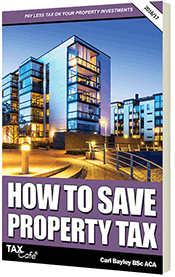Stamp Duty Land Tax:
The New Averaging Relief
Save SDLT on multiple residential properties
A NEW averaging relief will soon be available to reduce the amount of Stamp Duty Land Tax arising on multiple purchases of residential property.
The new relief will apply from the date of Royal Assent to the Finance Act 2011.
The latest stamp duty land tax planning information can be found in our guide:
How to Save Property Tax
Wealth Warning
If substantial completion of a property transaction takes place before the date of Royal Assent, the new relief will not be available.
The new averaging relief will only apply to multiple residential property purchases. The existing rules will continue to apply to non-residential property.
Under the new relief, the rate of Stamp Duty Land Tax will be based on the average consideration paid for each ‘dwelling’: but with an overall minimum rate of 1%. The relief will not be automatic, but can be claimed by the purchaser.
This new approach to taxing multiple property purchases could cut the rate of Stamp Duty Land Tax on some large property purchases from 5% to 1%.
Example 1
In May 2011, Jat bought five houses from a developer for a total consideration of £1.2m. Stamp Duty Land Tax was charged at 5%: £60,000.
Jat makes another similar purchase in October but, under the new relief, can claim a reduction in the Stamp Duty Land Tax charge. The average price for each property is £240,000, so the Stamp Duty Land Tax rate will now be just 1%, giving a total charge of only £12,000.
This result is clearly much fairer and is exactly what common sense should always have dictated. The new relief goes even further, however, and could actually be used to reduce the Stamp Duty Land Tax charge on a single large property.
Example 2
Pippa is planning to buy a new house in Middleton at a cost of £550,000. Stamp Duty Land Tax will be payable at 4% and will amount to £22,000. To reduce this cost, she does two things.
Firstly, she waits until after the date of Royal Assent.
Secondly, she arranges to buy two small flats from the same developer at the same time as her new house. The flats cost £70,000 each, bringing her total consideration to £690,000, but the average consideration is now just £230,000. Under the new relief, Pippa can therefore claim a reduction in her Stamp Duty Land Tax charge to just £6,900 (1%).
Hence, by buying the flats at the same time as the house, Pippa has saved £15,100. That’s equivalent to getting a discount of almost 11% on the flats!
A Major Benefit for Property Investors
Subject to any changes to the proposed new relief before it is finalised, it currently appears that self-contained flats will each constitute a separate ‘dwelling’ for the purposes of the relief. This could provide a major benefit for property investors buying larger properties.
For example, if an investor buys a property which has been divided into four flats, this would appear to constitute four dwellings, so that averaging relief can be claimed and potentially reduce the Stamp Duty Land Tax charge to just 1%.
Mixed Purchases
The new relief will not apply to non-residential property, even when it forms part of a larger ‘mixed’ purchase.
Example 3
Rhys buys a development which consists of four houses and a shop for a total price of £625,000. The shop alone is worth £145,000.
Excluding the shop, the average price of the houses is £120,000. A claim under the new relief would reduce the rate of Stamp Duty Land Tax on the houses to 1%: the minimum rate permitted under the relief.
The relief is not available on the shop, however. As the aggregate consideration for the whole transaction is £625,000, the rate of Stamp Duty Land Tax applying to the shop is 4%, giving rise to a charge of £5,800.
So Rhys will pay Stamp Duty Land Tax of £4,800 on four houses worth a total of £480,000, but will also pay £5,800 on one shop worth just £145,000. This from a Government which claims to be determined to make tax simpler and fairer!
Stamp Duty – Fixtures & Fittings
There is a great deal of misunderstanding over the issue of Stamp Duty Land Tax (SDLT) on fixtures and fittings.
Firstly, it must be understood that ‘fixtures’ are part of the fabric of the building and are therefore subject to SDLT. This includes items such as fitted kitchens, baths, toilets, sinks, etc.
Moveable fittings, however, are not part of the fabric of the building and therefore not subject to SDLT. This includes furniture, carpets, curtains and ‘white goods’ such as fridges, freezers and washing machines.
It is therefore often possible to allocate a small part of a property’s purchase price to the moveable fittings in the property. A small alteration in the purchase price of a property can sometimes make an enormous difference to the amount of SDLT payable when it reduces the price below one of the key thresholds.
This is fine as long as the allocation is reasonable (you can expect HM Revenue and Customs to be vigilant).






